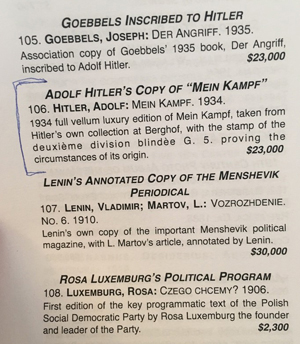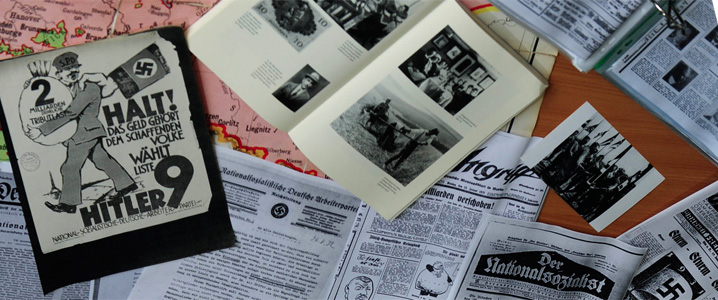 The New York Times reported on February 7, 2019 about a court decision in which the Austrian government has to pay a property owner in Braunau, a town of about 16,000 people in upper Austria, $1.7 million dollars for undervaluing the apartment building in which Hitler was born in 1889 and lived until the age of 3.
The New York Times reported on February 7, 2019 about a court decision in which the Austrian government has to pay a property owner in Braunau, a town of about 16,000 people in upper Austria, $1.7 million dollars for undervaluing the apartment building in which Hitler was born in 1889 and lived until the age of 3.
Beyond valuation is the problem of what to do with the property. In Cologne the five story Gestapo headquarters was turned into a Jewish Museum. Other German inhumane relics have been repurposed to recognize war crimes and prior misdeeds, seeking atonement and valuing life. Repurposing the camps to have museums that are unrelated to the Holocaust for some non-Jewish religious purpose raises a furor. Killing pits which become fields, and diabolic forced labor and incineration operations, preserved and/or bulldozed, take on the character of sanctified ground, a memorial for the victims, and a warning beacon for the future. Returning property and compensation to rightful owners or heirs includes real estate, lost businesses, art, and books, a subject recently treated in The Book Thieves, The Nazi looting of Europe’s libraries and the race to return a literary inheritance by Anders Rydell (2015, translated from Swedish in 2018).
At the recent antiquarian book fair in Oakland, Földvári Books of Budapest, Hungary offered amazingly dark facets of Judaica. Zoltán Földvári was one of four booksellers out of 160 at the Oakland fair who indicated they specialized in Judaica. He was also about the only antiquarian bookseller in Hungary who deals in Judaica. Földvári started his book finding and selling career in 2007. He buys and sells on the internet, at auctions, and at book fairs.
My uncle, Eric Bonner, an antiquarian bookseller in London from 1949 to 1970, said he could sell any book, finding it was the challenge. English estates raised money to pay death taxes by selling libraries. Obituaries, house for sale signs and rumors were good leads. How the bookseller acquired these books is no doubt an interesting story; a deft runner, a lucky find in a thrift shop, an underpriced gem in a bookstore, garage sale, estate sale, purchasing a retiring bookseller’s stock, or at an auction are possibilities. Knowing your clientele, potential buyers, helps to move books to new homes.
Who will be the next owner is also interesting. Submitting the volumes to state of the art testing for fingerprints, DNA, botanical and biological spores of germs to spectroscopic forensic analysis is the equivalent to 23 and Me. Disinterred pages could produce a sequel to Umberto Eco’s 1980 novel, The Name of the Rose. A history of what dictators read may be gleaned from Daniel Kalder’s 2018 study, Dictator Literature: A history of despots through their writing.
Here the issue is not returning books to their owners, but who are the purchasers. The following wares, a most unlikely set of book fellows lie in a column. They are directed to enthusiastic collectors, political ideologues, ne’er do wells with furtive shrines and nefarious purposes. Institutional buyers, university or public libraries were good, but it is unlikely that the book will ever come on the market again, barring sophisticated book thieves.
The price tag for Eichmann, Engels, Goebbels, Hitler, Lenin, Luxemburg, and Marx, in Hebrew, English, German, Russian, Polish, and French is $146,000. The eight volumes are about Nazis, the Holocaust, socialism, and communism. What an incredible and sorrowful concatenation; an ironic contrarian marvel to find them in the same column. Some are extremely scarce and unique association copies; we know who owned them. The reader’s imagination whirls with the possibilities.
Most books do not have victims. These volumes are fruits of poisonous trees. Booksellers are not bound by the European Union policy of droit moral, providing royalties to authors for books checked out from a library, use of reference books that do not circulate, or the resale of art, which provides a continuing income to its creator. Proceeds should be directed toward the care of victims of the tyrants. The royalties for the 1939 American edition of Mein Kampf went to benefit of Jewish victims.
When Hitler plotted the destruction of the Jews he is said to have responded to a warning that he could go down in infamy for killing Jews as German national policy, with the comment, “Who remembers the Armenians?” referring to the Armenian massacre. The Armenians are well remembered and a continuing contentious part of the genocide litany. The creation of the word “genocide” in the early 1940s was translated in 1951 to World Court prosecutable crimes against humanity.
Republished from San Diego Jewish World


























